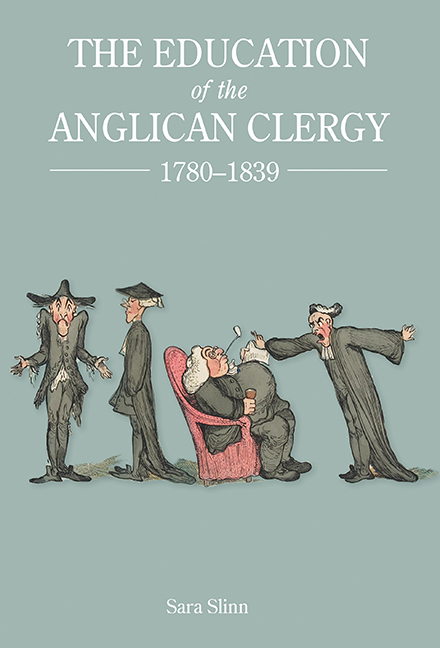Book contents
- Frontmatter
- Contents
- Illustrations
- Acknowledgements
- Abbreviations
- Introduction
- Part One Entrants to the Clerical Profession, 1780–1839
- 1 Recruitment to the Established Church
- 2 Episcopal Ordination: Policy and Practice
- Part Two Routes to Ordination
- Conclusion
- Appendix 1 Ordination Profiles of Bishops, 1780–1839
- Appendix 2 A Note on Methodology
- Bibliography
- Index
- Miscellaneous Endmatter
1 - Recruitment to the Established Church
from Part One - Entrants to the Clerical Profession, 1780–1839
Published online by Cambridge University Press: 30 August 2017
- Frontmatter
- Contents
- Illustrations
- Acknowledgements
- Abbreviations
- Introduction
- Part One Entrants to the Clerical Profession, 1780–1839
- 1 Recruitment to the Established Church
- 2 Episcopal Ordination: Policy and Practice
- Part Two Routes to Ordination
- Conclusion
- Appendix 1 Ordination Profiles of Bishops, 1780–1839
- Appendix 2 A Note on Methodology
- Bibliography
- Index
- Miscellaneous Endmatter
Summary
Section A: Absolute numbers of entrants to the diaconate
Contextualising recruitment needs
During the late Hanoverian period, England and Wales experienced an unprecedented change in social and economic environment, fuelled by dramatic population increase and major technological innovation in both the agricultural and manufacturing economies. Demographic growth was by no means evenly spread across the country: sparsely populated areas with a low density of parishes became major urban industrial centres in just a few decades, whilst some migrants left their birthplaces in such numbers that significant rural depopulation resulted. With the concomitant parochial pastoral challenges, the Church of England struggled to respond. Whilst the true extent of the overhaul needed by the Church in its administrative structures and financial foun-dations probably did not become clear to those in a position to bring about root-and-branch reforms until the end of this period, prelates, parliamentarians and parishioners were nevertheless active in searching for the causes of pastoral inefficiency, proposing remedies, devising legislation, implementing enactments and resourcing a whole host of measures. Although significant structural alterations to Church administration and modes of operation – part of what Thompson has classified as an ‘organisational revolution’ – followed the establishment of the Ecclesiastical Commission and thus belong to the 1830s and later, reform had its origin in the recognition of late Hanoverian churchmen that the way in which the Church went about its work could, and should, be better.
In the sixty years covered by this study, change was, to use Peter Virgin's term, gradualist. Kenneth Thompson summarised those actions which aimed to solve the Church's problems in this period as essentially a series of modest adjustments, acting through existing agencies, facilitated by legislative solu-tions. Gradual the reforms may have been – in some cases, ineffective and counter-productive – and with justice it may be said that concern for established interests prevented the bishops from exercising their regulative powers fully, and made all but the most radical shy away from proposing drastic reform; however, at the diocesan level, administrative machinery was being developed and more management data about a wide range of activities was being collected, and amongst the clergy, many were delivering ministries based on an enlarged pastoral vision to ever-expanding populations.
- Type
- Chapter
- Information
- The Education of the Anglican Clergy, 1780–1839 , pp. 19 - 74Publisher: Boydell & BrewerPrint publication year: 2017

